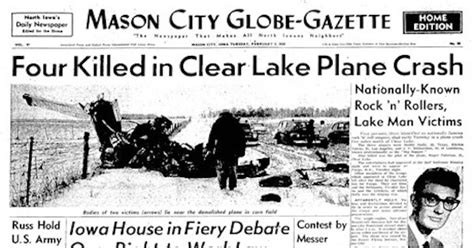THE DAY THE MUSIC DIED
“And the three men I admire most
The Father, Son, and the Holy Ghost
They caught the last train for the coast
The day the music died.”
Don McLean
American Pie
1971
What a whirlwind the last few days have been!
First the scramble to close out the apartment and put all our possessions in storage (except for those items needed for our grand excursion out west), then the drive to Ohio to declutter and empty out mom and dad’s house—and its possessions accumulated since 1962—for an estate sale, then the drive back to Virginia with Snapper and his new car, then to North Carolina to visit with my youngest daughter (where I am now), then to Florida in a few days to meet Kimberly’s tribe for a visit to the land of the mouse, and then off to Oklahoma and Idaho.
Whew!
Even amidst the frenzied chaos there are priceless nuggets. My first Lionel train set discovered in an old box in the garage, a pump-action Winchester rifle dad left for me (hidden in a closet corner), and an invaluable assortment of notes, bibles, and mom’s personal artwork. Not to mention the time spent with all four sisters in one place or the helping hand provided by a friend (thanks Chris).
One of the joys of being back in Ohio is the chance to meet with family and old high school chums. So, one morning I had breakfast with Terry Wyant, the one-time drummer of our local rock-and-roll band, The Henchmen. We met at Mom’s Restaurant (where else) and chatted about old classmates, our summer baseball league team and our hair-raising slide off the road—in his old Corvair—dodging mailboxes and telephone poles as we crossed three or four front yards near Red Lion, Ohio. It is a wonder any of us are alive!
At any rate, sometime during the conversation, Terry mentioned that as a youngster, he observed a jet plane go down near Ridgeville, Ohio. He said he was the first one on the scene, trudging through muddy fields along a tree line, and saw the pilot who was completely charred.
That was the very first time I had heard about any such crash so close to where we lived.
And so close to Ridgeville.
Nothing ever happens in Ridgeville. It is a sleepy little hamlet, located on Route 48 between Lebanon and Dayton. There is a bar there, a handful of houses, nearby fruit farms and orchards, and Ridgeville Community Church. The church and its congregation played a significant role in my life. The pastor, Ray Shelton and his wife Jean, were terrific teachers of the Word and valuable role models. Their oldest daughter, Chery, was a true heartthrob and my high school sweetheart.
My point is, that in all my years hanging around Ridgeville, I had never heard of a nearby plane crash.
A couple days later, again over breakfast at Mom’s Restaurant, I asked my old friend Dennis Centers—former mayor of Franklin, Ohio and holder of an honorary chair at the “Liar’s Club” table in the middle of Mom’s Restaurant—if he knew anything about a plane crash near Ridgeville. From Terry’s description of the crash site, it was close to a creek that ran by the house along Lower Springboro Road where Dennis spent his childhood. “Oh yes,” he exclaimed, “when I was a small boy, my dad was outside and heard a loud noise. My dad and uncle were at the crash site when the firetrucks arrived.”
Dennis said the site was quickly cordoned off by investigators.
A quick review of a database of military-related crashes in Ohio for the late 1950s to the mid-1960s yielded nothing. I called Eddie Shelton—Chery’s brother—to ask if he knew anything about it. He told me they used to regularly run across aircraft pieces in the fields and woods behind the church. His dad, Reverend Shelton, identified some of the parts that Eddie brought back to the house. He should know: Chery and Eddie’s dad was a pilot during the postwar Berlin Airlift (late June 1948 to mid-May 1949).
I love a mystery.
My imagination kicked into overdrive. Especially when it concerns a Cold War-era crash that is apparently unrecognized in normal military reporting channels. Why no official record of the crash? Did a pilot hijack an aircraft from one of the nearby military air bases? Was he on some sort of secret mission? Was the military testing a top-secret communications device?
Like the black box?
Black box?
During our classified missions to the Tonkin Gulf aboard the “hog-nose” RC-135 in the early 1970s, just next to our Chinese language positions sat a mysterious black box. At the time, it was the height of our aerial operations over Vietnam—“Operation Linebacker” to force the release of American POWs—with USAF B-52s and other aircraft pounding targets around Hanoi and Haiphong. When viewed from our limited number of small windows on the aircraft, it seemed like the fireworks on a Fourth of July holiday on steroids. SAM contrails, aircraft dropping out of the sky like flaming arrows … the full Monty.
Wearing our headsets, we listened to it all in real time.
Back to the black box. It was about the size of a small college dormitory room refrigerator. It wasn’t on all the airframes we flew into the combat zone, just a couple. But none of us knew what it was or its purpose. It was serviced after the plane landed back at Kadena AFB in Okinawa, by a special team of technicians. And they didn’t talk. Some of us reasoned it was a “doomsday device” of sorts—designed to blow the plane, the expendable human crew and all the top-secret equipment aboard to smithereens in the event we were shot down. Many years afterward, a friend who was one of the maintenance crew that rode with us on the hogs, told me the black box actually contained an experimental communications pod in contact with classified sites located at places like Monkey Mountain.[1]
But back to the plane crash. Subsequent information about the mysterious crash came in small bits. One can acquire a picture on-line of the crash site, showing parts of a Lockheed T-33 “Shooting Star” trainer jet. According to this information, the aircraft went down in 1959. Lockheed produced over 6500 of the subsonic T-33’s. The aircraft made its first flight in 1948 and was finally retired by the Bolivian Air Force in 2017. The aircraft line had a glorious run, but my particular interest was stirred by one such anonymous aircraft that died in a mysterious and unexplained fireball, its unnamed pilot charred beyond recognition, crashing into an ordinary group of trees, near an ordinary group of farm fields, bordering an ordinary creek, near the ordinary hamlet of Ridgeville.
Maybe the Cold War era is filled with numerous such stories.
Terry and I are determined to dig further into this one.
Stay tuned.
As I was mulling all this over, (and more to the point of this missive), no matter how mysterious, ordinary or momentous that occurrence in a remote corner of SW Ohio was in 1959, it was superseded in importance by another airplane crash earlier in the year. This is the juxtaposition and the irony. Instead of a military aircraft, this crash involved a small chartered commercial aircraft. Instead of the crash site being rural Ohio, it was rural Iowa. The crash claimed the lives of three rising superstars of the early rock-and-roll era and provided the context for “the day the music died” line by Don McLean in his hit song of 1972.
Only history buffs and classic rock aficionados understand the significance of the event. The crash of a chartered Beechcraft Bonanza plane just outside Mason City, Iowa (on its way to Minnesota) claimed the lives of 22-year-old Buddy Holly,[2] 28-year-old J.P. Richardson (“the Big Bopper” radio persona whose song “Chantilly Lace” was racing up the charts), and 17-year-old Ritchie Valens (of “La Bamba” fame). As in all such crashes, there are head-scratching events and survivors left asking broader questions about fate and life: for example, one tour member of Holly’s band, Waylon Jennings, gave up his seat on the plane to the Big Bopper shortly before takeoff.[3]
Moreover, as I was researching the Ridgeville jet plane crash, someone sent me an on-line article by Dwight Rowe about yet another crash near my hometown, this one occurring in mid-July1950. A SAC B-50D Superfortress bomber, loaded with a compliment of weapons including at least one Mark-4 nuclear bomb, crashed in a fiery fireball that killed all 16 crewmembers on board. I was still in diapers at the time, but never heard my parents, family or any of my teachers during my educational years, talk about the incident. It was the height of the Cold War back then, and Warren County—our home county in SW Ohio—was on the landing route to nearby Wright Patterson AFB, one of the nation’s premier air bases.
At any rate, the crash occurred close to Route 741 and near the town of Mason, Ohio. The same road, Route 741, runs through Springboro, Ohio. The aircraft was on its way from Texas to England with a refueling stop scheduled at nearby Wright Patt. Fortunately, the explosive package designed to trigger the bomb was not installed. As a result, there was no nuclear detonation. Nevertheless, the force of impact caused a crater over twenty feet deep. Spectators reported the crash scene was a gruesome sight with body parts hanging from limbs and strewn all over the ground. Air Force investigators soon arrived on the scene but told no one about the search for the nuclear weapon.
“Sigh.” That was the world we lived in—fallout shelters, the psychological fear of impending nuclear war and the best music the world has ever produced.
Perhaps I’m the only one who would attempt to link a return trip to my childhood home, a chance breakfast conversation about a plane crash, Ridgeville, the black box, “the day the music died,” and a near nuclear catastrophe in one missive.
My only excuse is that’s the way my brain works; the way I’m wired.
[1] During the Vietnam War, a classified Air Force and Marines facility was located high on Son Tra Mountain, nicknamed “Monkey Mountain” because of the numerous monkeys that inhabited the mountain jungle.
[2] The crash took the life of Holly—a talented young Texan musician and lyrist—just as he was turning the musical world (with his band the Crickets) on its ear with songs like “Peggy Sue,” “Oh Boy!,” and “That’ll Be the Day.”
[3] “This day in history, February 3, 1959,” History.com, Mar 3, 2010.




